Related Research Articles

Cortinarius rubellus, commonly known as the deadly webcap, is a species of fungus in the family Cortinariaceae, native to high-latitude temperate to subalpine forests of Eurasia and North America. Within the genus it belongs to a group known as the Orellani, all of which are highly toxic. Eating them results in kidney failure, which is often irreversible. The mushroom is generally tan to brown all over, with a conical to convex cap 2.5 to 8 centimetres in diameter, adnate gills and a 5.5 to 11 cm tall stipe.

Cortinarius is a globally distributed genus of mushrooms in the family Cortinariaceae. It is suspected to be the largest genus of agarics, containing over 2,000 widespread species. A common feature among all species in the genus Cortinarius is that young specimens have a cortina (veil) between the cap and the stem, hence the name, meaning curtained. Most of the fibres of the cortina are ephemeral and will leave no trace once gone, except for limited remnants on the stem or cap edge in some species. All have a rusty brown spore print. The common names cortinar and webcap refer to members of the genus. Due to dangerous toxicity of several species and the fact that it is difficult to distinguish between various species of the genus, non-expert consumption of mushrooms from the genus is discouraged.

Orellanine or orellanin is a mycotoxin found in a group of mushrooms known as the Orellani of the family Cortinariaceae. Structurally, it is a bipyridine N-oxide compound somewhat related to the herbicide diquat.

The Cortinariaceae are a large family of gilled mushrooms found worldwide, containing over 2100 species. The family takes its name from its largest genus, the varied species of the genus Cortinarius. Many genera formerly in the Cortinariaceae have been placed in various other families, including Hymenogastraceae, Inocybaceae and Bolbitiaceae.

Cortinarius caperatus is an edible mushroom of the genus Cortinarius found in northern regions of Europe and North America. It was known as Rozites caperata for many years before genetic studies revealed that it belonged to the genus Cortinarius. The fruit bodies appear in autumn in coniferous and beech woods as well as heathlands in late summer and autumn. The ochre-coloured cap is up to 10 cm (4 in) across and has a fibrous surface. The clay-colored gills are attached to the stipe under the cap, and the stipe is whitish with a whitish ring. The Latin specific name, caperatus, means wrinkled, and refers to the distinctive texture of the cap. The flesh has a mild smell and flavor.

Cortinarius violaceus, commonly known as the violet webcap or violet cort, is a fungus in the webcap genus Cortinarius native across the Northern Hemisphere. The fruit bodies are dark purple mushrooms with caps up to 15 cm (6 in) across, sporting gills underneath. The stalk measures 6 to 12 centimetres by 1 to 2 cm, sometimes with a thicker base. The dark flesh has a smell reminiscent of cedar wood. Forming symbiotic (ectomycorrhizal) relationships with the roots of various plant species, C. violaceus is found predominantly in conifer forests in North America and deciduous forests in Europe.

Cortinarius archeri is a species of mushroom in the genus Cortinarius native to Australia. The distinctive mushrooms have bright purple caps that glisten with slime, and appear in autumn in eucalypt forests.

Cortinarius cinnamomeus, also known as the cinnamon webcap, is a basidiomycete mushroom of the genus Cortinarius. The fungus produces brown fruit bodies with caps up to 6 cm (2.4 in) wide and stems up to 12 cm (4.7 in) long. The closely crowded gills underside the cap are initially yellow before turning brown. Cortinarius cinnamomeus is common in damp places in coniferous forests. It is distributed throughout the temperate zone of the Northern Hemisphere.

The Orellani are a group of seven related species in the genus Cortinarius that have been classified as a section of the subgenus Leprocybe or a subgenus in their own right. They are among world's most poisonous mushrooms as they contain the highly toxic compound orellanine. The best-known species are the deadly webcap and the fool's webcap, C. orellanus.
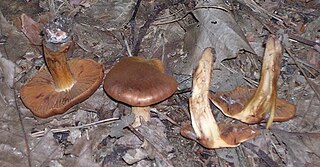
Cortinarius orellanus, commonly known as the fool's webcap or fools webcap, is a species of deadly fungus in the family Cortinariaceae native to Europe. Within the genus it belongs to a group known as the Orellani, all of which are highly toxic—eating them results in kidney failure, which is often irreversible. The mushroom is generally tan to brown all over.

Cortinarius vanduzerensis is a species of mushroom in the family Cortinariaceae. Described as new to science in 1972, it is known only from the Pacific Northwest region of North America, where it grows under conifers such as spruce, hemlock, and Douglas-fir. The fruit bodies of the fungus, or mushrooms, have a slimy dark chestnut-brown cap that becomes deeply radially grooved or corrugated in maturity, and reaches diameters of up to 8 cm. The gills on the underside of the cap are initially pinkish-buff before becoming pale brown when the spores mature. The stem is lavender, measuring 10–18 cm (4–7 in) long and 1–2 cm thick. The mushroom produces a rusty-brown spore print, with individual spores measuring 12–14 by 7–8 micrometers. The edibility of the mushroom has not been determined, and it has been described as "much too slippery to be of value".
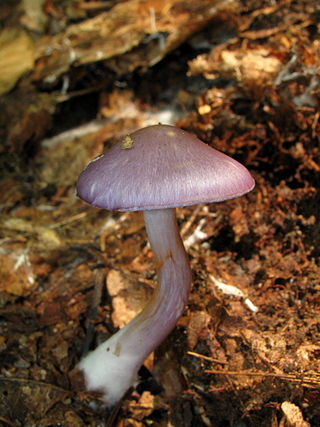
Cortinarius iodes, commonly known as the spotted cort or the viscid violet cort, is a species of agaric fungus in the family Cortinariaceae. The fruit bodies have small, slimy, purple caps up to 6 cm (2.4 in) in diameter that develop yellowish spots and streaks in maturity. The gill color changes from violet to rusty or grayish brown as the mushroom matures. The species range includes eastern North America, Central America, northern South America, and northern Asia, where it grows on the ground in a mycorrhizal association with deciduous trees. The mushroom is not recommended for consumption. Cortinarius iodeoides, one of several potential lookalike species, can be distinguished from C. iodes by its bitter-tasting cap cuticle.

Cortinarius cyanites is a basidiomycete fungus of the genus Cortinarius native to Europe.
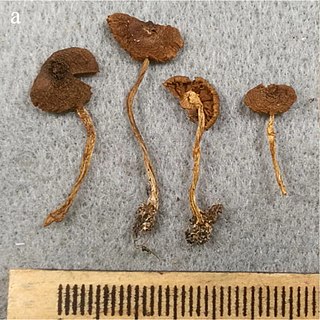
Cortinarius subsaniosus is a species of webcap mushroom known from north and central Europe, where it grows on sandy soil in association with willows. It produces small yellowish brown mushrooms. The species was described in 2020 by Kare Liimatainen and Tuula Niskanen. Its name refers to its affinity to C. saniosus, to which it is closely related. Along with five other British webcaps, C. subsaniosus was selected by Kew Gardens as a highlight of taxa described by the organisation's staff and affiliates in 2020.
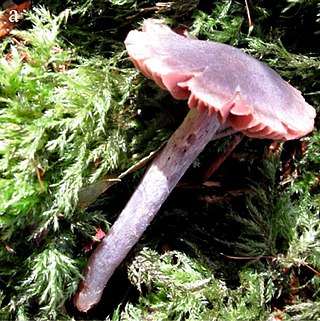
Cortinarius britannicus is a species of webcap. It is known only from Scotland, where it was found on clay soil among mosses under beech. The species produces small, purplish mushrooms. Along with five other British webcaps, C. britannicus was selected by Kew Gardens as a highlight of taxa described by the organisation's staff and affiliates in 2020.
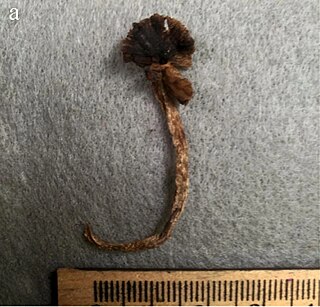
Cortinarius aurae is a little brown mushroom found in Europe and North America, originally described from a UK specimen in 2020. It was named in honour of the describing authors' new born daughter. Along with five other British webcaps, C. aurae was selected by Kew Gardens as a highlight of taxa described by the organisation's staff and affiliates in 2020.
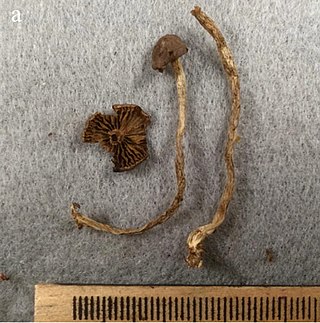
Cortinarius scoticus is a little brown mushroom known from central and northern Europe, where it grows in pine forests. It was described in 2020, and named for Scotland, where it was first found. Along with five other British webcaps, C. scoticus was selected by Kew Gardens as a highlight of taxa described by the organisation's staff and affiliates in 2020.
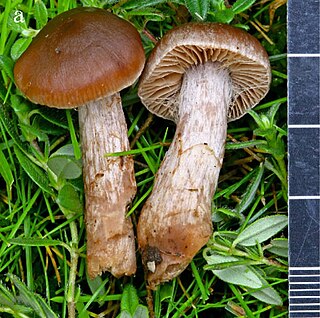
Cortinarius ainsworthii is a species of webcap. It is known from central and Northern Europe, where it grows in a variety of habitats. The species was first described in 2020, and was named in honour of the mycologist A. Martyn Ainsworth. Along with five other British webcaps, C. ainsworthii was selected by Kew Gardens as a highlight of taxa described by the organisation's staff and affiliates in 2020.

Cortinarius heatherae is a species of webcap. It was described in 2020 by Andy Overall from a specimen found at Heathrow Airport. He named the species in honour of his wife, Heather Overall. Along with five other British webcaps, C. heatherae was selected by Kew Gardens as a highlight of taxa described by the organisation's staff and affiliates in 2020.
References
- ↑ Liimatainen K, Niskanen T, Dima B, Kytövuori I, Ammirati JF, Frøslev TG (2014). "The largest type study of Agaricales species to date: bringing identification and nomenclature of Phlegmacium (Cortinarius) into the DNA era". Persoonia. 33: 98–140. doi:10.3767/003158514X684681. PMC 4312940 . PMID 25737596.
